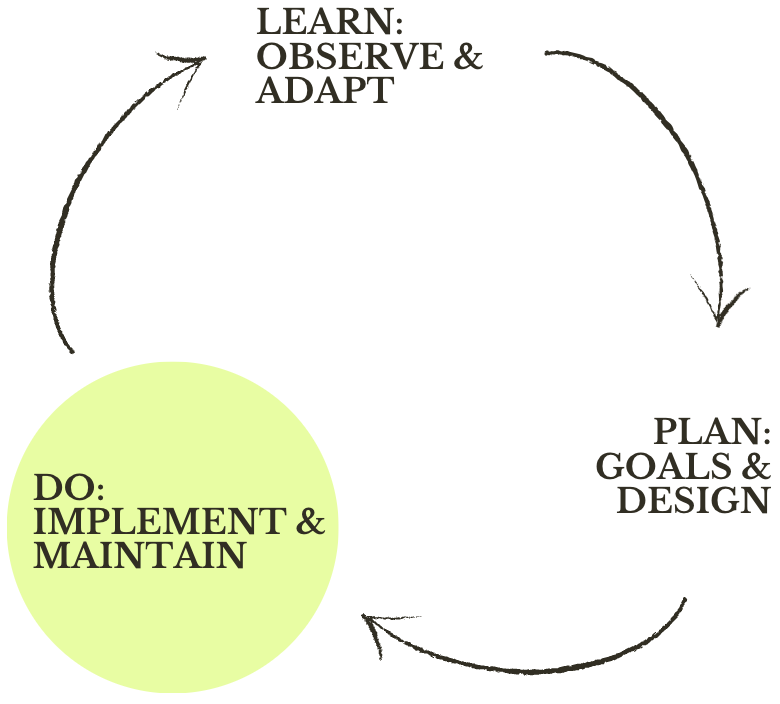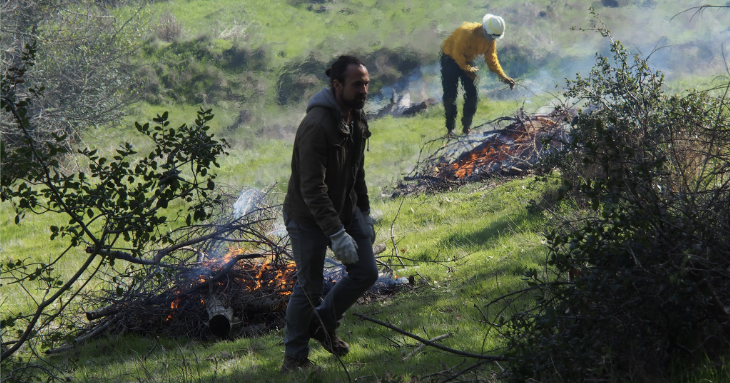DO: Implement & Maintain
Get help on where, when, and how to use Sonoma County’s most common vegetation management and land stewardship practices.



Pile burning in a grassland near mixed hardwood forest on Montini Open Space Preserve. Photo: Sonoma Ecology Center.
VEGETATION COMMUNITIES
Better understand Sonoma County’s many landscape, vegetation, and ecosystem types.
Practices for all vegetation communities:
- Beneficial Fire – often the long-term goal for vegetation management
- Retaining and Creating Habitat Features – for birds, mammals, amphibians, invertebrates and a host of other species
- Wildlife Habitat Brush Piles – create habitat while repurposing / using excess wood
- Nesting Bird Surveys – look before you work and protect those birds
- Targeted Grazing – highly efficient in the right settings
- Post-fire Land Care – foster regeneration and recovery, and avoid damage after wildfire
- Managing Invasive Species – release native vegetation communities from invasives, and avoid new invasions
- Managing Woody Material – what to do with all that wood?
- Headcut Gully Stuffing – turn fuels into flows*
- Lop and Lay Brush Wattles – onsite recycling of modest amounts of material while stabilizing soil and sinking runoff
- Lop and Scatter – onsite recycling of modest amounts of material
- Making and Using Biochar – store that carbon!
- Pile Burning – the most efficient method in many situations
- Retaining and Creating Habitat Features – for birds, mammals, amphibians, invertebrates and a host of others species
- Wildlife Habitat Brush Piles – create habitat while repurposing excess wood
- Wood Chipping – reduces ladder fuels by restructuring woody material, but placement can be tricky
The benefits of practices such as thinning or limbing are only achieved when they are combined with an appropriate strategy for handling cut plant material (see Managing Woody Material). On many sites, cutting the material is the easy part; the disposition of that material is more challenging.
Practices related to grasslands:
- Mowing – seasonal timing, mowing height, equipment choices
- Managing Woody Species Encroachment – keep Douglas fir, coyote brush, and other fast-growing species from taking over
Practices related to woodlands and forests:
- Thinning – an important practice for fire resilience. How to enact it without compromising the health of your forest
- Limbing Up Trees – critical for reducing the severity of a wildfire
- Retaining and Creating Habitat Features – for birds, mammals, amphibians, invertebrates and a host of others species
- Shaded Fuel Breaks – fire-calming strips coordinated by agencies across large swathes of land
Review Resources for Implementing: including permitting, funding, hiring and sourcing professionals, and groups to collaborate with.
How not to be overwhelmed
When you feel like caretaking the land is too confusing, expensive, or daunting… take heart. Some ways to do less, and do it smarter…
- Focus on creating health and resilience in one or two smaller areas that matter most to you. Maybe it’s the view out of your kitchen window, or an area you often see wildlife pass through.
- With invasive weeds, focus on first containing and then shrinking the perimeter. Go from the least-invaded areas to the most-invaded.
- Start by getting more eyes on the land; crowd-source the task of prioritizing.
- Spend time getting familiar with the biggest native trees on the site, and learn to see what they most need to thrive. How much space and light do they want? If they are not getting enough, you may want to revisit the Thinning Practice.
*alliteration courtesy of Brock Dolman, Occidental Arts & Ecology Center

